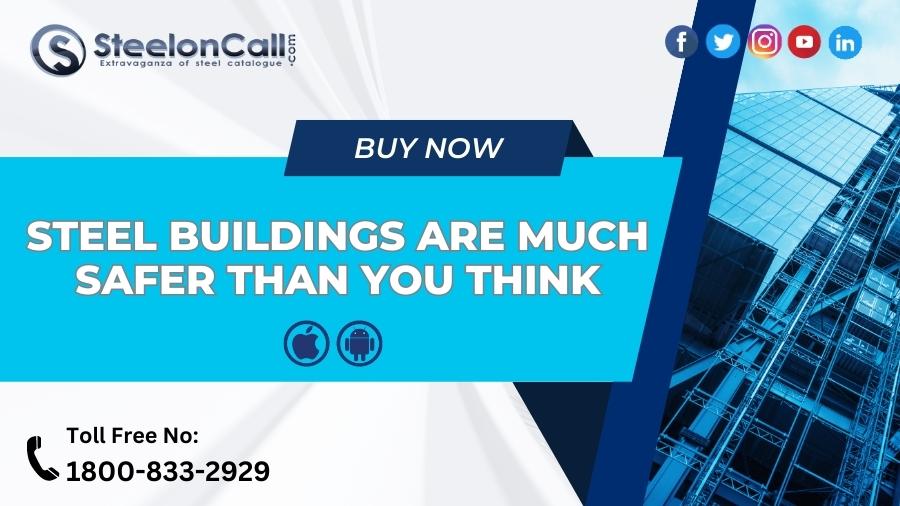Steel Buildings Are Way Much Safer Than You Think, Know How!

Steel buildings have become popular in modern construction due to their durability, affordability, and sustainability. However, some still believe steel buildings are unsafe and prone to collapse. This misconception is based on a need for more understanding of steel buildings' structural strength and fire resistance. This blog will discuss the safety features of steel buildings, common misconceptions, advantages over traditional construction, and safety measures in steel building construction.
Steel buildings and safety
Steel is known for its strength and long durability, making it an ideal material for building construction. The structural strength of steel buildings comes from the material's properties, which allow for a high strength-to-weight ratio. Steel is also more flexible than other building materials, making it less likely to crack or break under stress.
Benefits of steel in construction include its ability to withstand high winds, heavy snow loads, and seismic activity. Steel buildings are also fire-resistant, as steel does not burn and does not contribute to the spread of flames. This makes steel buildings safer in case of fire, reducing the risk of injury or death.
Common misconceptions about steel buildings
Despite the safety features of steel buildings, some things still need to be clarified about their safety. One of the perceived risks of steel buildings is lightning strikes. However, steel is an excellent conductor of electricity, so lightning will be conducted to the ground, reducing the risk of damage to the building or its occupants.
Another misconception is that steel buildings are unsuitable for areas with high seismic activity. However, steel buildings are designed to be flexible and absorb energy during seismic events, making them more resistant to earthquakes. In fact, steel buildings have been known to withstand earthquakes better than traditional buildings made of masonry or concrete.
Resistance to extreme weather conditions is also a concern for some people. However, steel buildings are designed to withstand high winds, heavy snow loads, and extreme temperatures. They can also be engineered to resist hurricanes, tornadoes, and other severe weather conditions.
Advantages of steel buildings over traditional construction
Steel buildings have gained popularity recently due to their numerous advantages over traditional construction. The advantages of Steel buildings over traditional construction methods are:
Speed of construction: Steel buildings can be pre-engineered and prefabricated off-site, which allows for faster construction times and fewer on-site delays. This can save time and money for the owner.
Design flexibility: Steel buildings can be designed to fit specific needs and can be easily modified or expanded as needed. This allows for greater flexibility in design and function.
Energy efficiency: Steel buildings with energy-efficient features such as insulation, solar panels, and green roofs can be built. Lower energy costs and a smaller carbon footprint may result from this.
Low maintenance: Steel buildings require less maintenance than traditional buildings, as they are less prone to pests, moisture, and rot. This can result in lower maintenance costs over the life of the structure.
Sustainability: Steel is a recyclable material, which makes steel buildings a sustainable choice. They can also be designed with sustainable features such as rainwater harvesting systems and green roofs, further reducing their environmental impact.
Safety measures in steel building construction
Quality control in the manufacturing process is critical to ensuring the safety of steel buildings. Steel manufacturers must adhere to strict quality control standards to ensure that the steel used in building construction meets or exceeds industry standards. This includes testing for strength, durability, and fire resistance.
Regular inspections and maintenance are also important for the safety of steel buildings. Owners of steel buildings should have their structures inspected regularly to identify any potential safety hazards. This includes checking for corrosion, damage, and wear and tear.
Implementation of safety standards and regulations is also essential in steel building construction. Building codes and regulations are in place to ensure structures are built to a certain level of safety. These codes and regulations must be followed during the design and construction of steel buildings to ensure the safety of the occupants.
Build with Confidence - Get High-quality Steel from SteelonCall!
In conclusion, Steel buildings are much safer than you might think, offering unparalleled protection from the elements, fire, and other hazards. SteelonCall is here to provide you with the best quality steel for all your construction needs. As a leading online steel provider, SteelonCall offers a wide range of steel products, including construction, fabrication, and special steel, all delivered directly to your door. With SteelonCall, you can trust that you're getting high-quality steel online, backed by our commitment to customer satisfaction. Choose SteelonCall for a safe, sturdy steel structure for your next building project.

